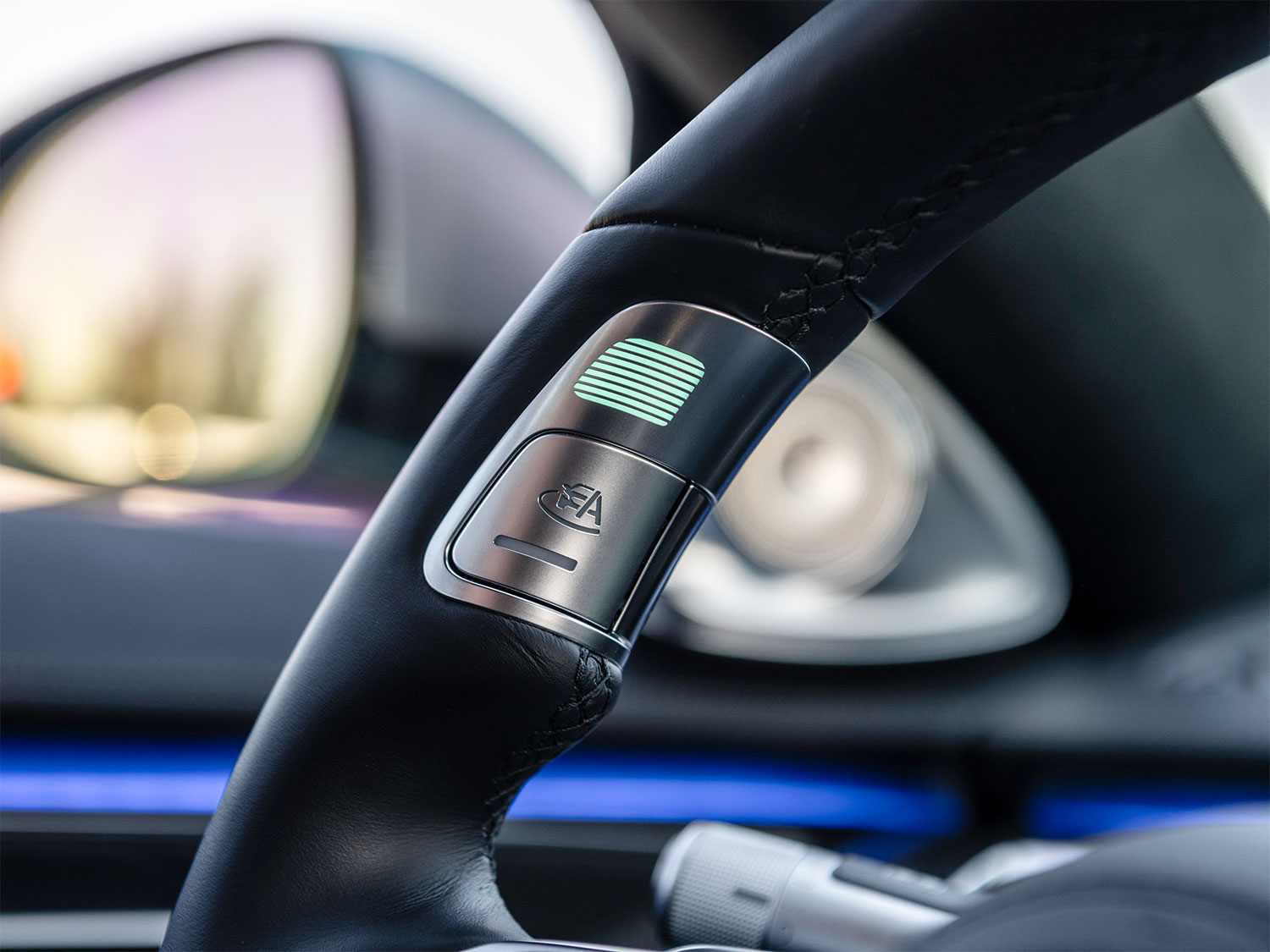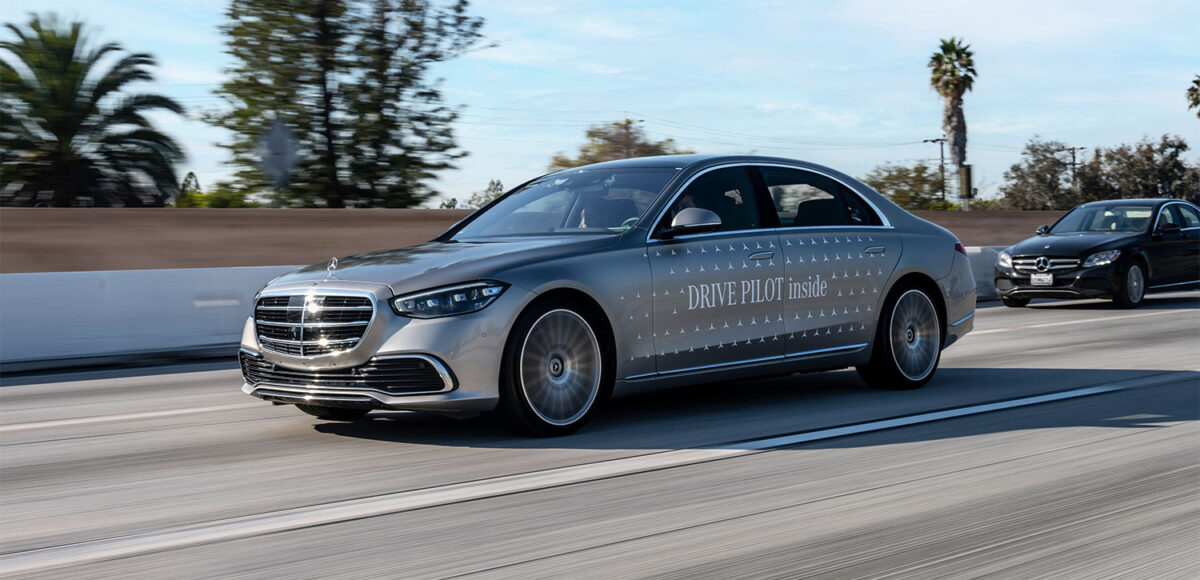What if you could push a little button in your car that allowed you to take your eyes off the road long enough to watch a movie while safely threading through thick traffic on the Santa Monica Freeway? What would you do with your newfound time if the car you were “driving” didn’t require you to pay attention because your new wheels, in fact, have a virtual super-tech chauffeur?
I did just that last week. I hopped behind the wheel of a new electric Mercedes-Benz EQS, got onto the Santa Monica Freeway, activated a divine heated/massaging seat, and handed the driving power over to the car while I blithely watched a YouTube video about tulips in the Netherlands. I didn’t die, and I’m here to write about it.
We’ve all been experiencing various levels of autonomous driving in our own cars for decades. Cruise Control was the first piece of the puzzle. That technology now seems quaint compared to much more recent advances that allow vehicles to stay in step with traffic, change lanes, and park our cars, all without driver input. If you own a Tesla or another luxury car that offers these assisted driving features, you are familiar with these perks. But even they are somewhat passé, as these systems are under the umbrella of Level 2 autonomy and require that our hands remain on the steering wheel at all times and our eyes stay fixed to the road.
What I experienced in that Mercedes-Benz on the 10 Freeway—with my feet not touching the pedals, my hands not touching the steering wheel, and my eyes glued to a generously sized hi-res video screen (and not facing the windshield)—was the next step in what will one day have us completely riding as passengers in our own vehicles. Welcome to Level 3 autonomy, which promises, under the right conditions, hands-free and feet-free steering, braking and accelerating.
For now, Mercedes-Benz is the only carmaker authorized in the U.S. to sell Level 3 autonomous features on its passenger vehicles. By the end of this year, Mercedes will offer California and Nevada drivers its proprietary autonomous driving system it calls Drive Pilot. Just push a button on the steering wheel and the system takes over. You can now take your eyes off the road. Yikes!
Drive Pilot hardware will be optional equipment on the 2024 Mercedes EQS (electric) sedans and the S-Class (gas version sedans.) Other models may include the option next year. An annual $2,500 subscription will activate Drive Pilot.

Of course, the program’s disclaimers are littered with caveats and warnings. But basically, under the right conditions—for now, this means that on certain California and Nevada freeways with clearly marked lane dividers, in dry and clear weather, and at speeds that are currently limited to 40 mph—the Mercedes-Benz will fully take over driving duties. You can read, watch a movie, or browse the internet in traffic. You can’t—like some Tesla owners who think otherwise and have met with doom—fall asleep or be otherwise out-of-it so as to not be ready to quickly resume driving responsibilities should an emergency or change in traffic/road conditions occur. At over 40 mph, the Level 2 system will engage, which requires a driver’s attention and hands on the steering wheel.
A camera mounted in the Mercedes video gauge cluster behind the steering wheel pays attention to eye movement and will notice if you nod off. In that case, the seat belt will vibrate and tug at you, bells will go off, and lights will flash. In other words, catnaps are a no-no.
Though Level 3 autonomy is new to the U.S., Mercedes-Benz has offered it as an option in Germany for about a year, with no deaths or accidents. A Mercedes spokesman declined to reveal how many vehicles on Germany’s highways are equipped with the technology.
As I rode along, passenger-like, in the driver’s seat of the Mercedes EQS in spotty traffic moving east approaching Downtown L.A., a Jeep in the lane to my left drifted uncomfortably close to my lane. I waited for the Drive Pilot to sense it and move to the right or at least brake to let the Jeep move in front of me.
There was a car in the lane to my right, and my vehicle had little wiggle room. Luckily, the Jeep driver realized he was moving into my lane and corrected his steering. I don’t know what would have happened if the Jeep guy had not realized his mistake. I didn’t sense that the Mercedes braked or moved a bit more to the right in my lane, so…
And there was a second incident where I felt concerned. Traffic was now moving at around 60 mph, and so the car was operating in Level 2 capacity. My hands were on the steering wheel, but my feet were not on the pedals. Traffic ahead was slowing and I felt we were traveling too fast for the stopped traffic ahead.
I waited for the brakes to apply automatically, but it didn’t seem to be coming in time for me to not sweat it. A bit shy of panicking, I applied the brakes and overrode the assisted driving system. The Mercedes engineer sitting shotgun assured me that the car would have applied the brakes and all would have been fine, but for my comfort level, it was a bit too close for comfort.
Of course, it could be that I was hyper-aware. Or hyper-concerned. I mean, I was sitting in a moving vehicle with a video playing, the extraordinarily adept massaging seat doing its thing, and the car acting as boss tooling down a crowded freeway. Maybe those two moments in an otherwise uneventful drive through Los Angeles traffic were nothing to worry about because this cutting-edge technology works. I’m eager to try it again!
Tara Weingarten is an award-winning journalist who wrote a decade-long weekly car review column in Newsweek and was Editor-in-Chief of VroomGirls, a popular automotive-focused website for women. Her work covering food, wine, spirits and travel, has appeared in Fortune, The Los Angeles Times, The New York Times, Wine Spectator, Los Angeles Magazine, Variety and GQ.







